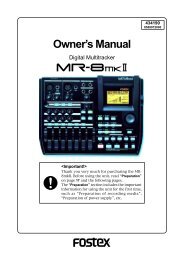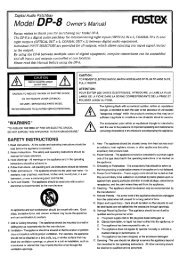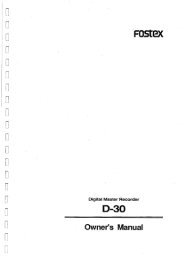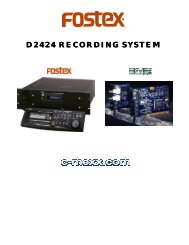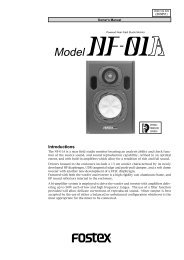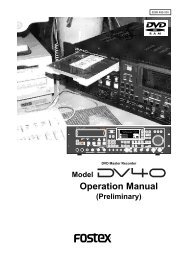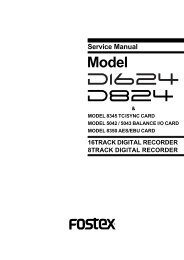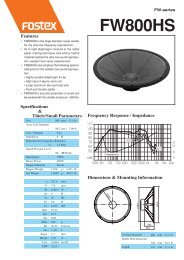Create successful ePaper yourself
Turn your PDF publications into a flip-book with our unique Google optimized e-Paper software.
Model VM88 Owner’s <strong>Manual</strong><br />
Effect Edit Mode<br />
The VM88 offers high quality ambient effects by employing the A. S. P. (<strong>Fostex</strong> Advanced Signal<br />
Processing Technology), which is exclusively developed by <strong>Fostex</strong>. With the A. S. P., you can<br />
obtain an incomparably clean and high density Hall Reverb, overwhelmingly clear Room Reverb<br />
and wonderfully hi-fidelity Plate Reverb. In addition to these typical Reverbs, the VM88<br />
provides not only various practical algorithms such as Delay, Chorus, Flanger and Pitch Bend,<br />
but some combinations of these are also available, e.g., Delay+Reverb.<br />
* A. S. P. (<strong>Fostex</strong> Advanced Signal Processing Technology)<br />
The A. S. P. is an exclusive new digital effect processing technology designed by<br />
<strong>Fostex</strong>. This method extracts maximum efficiency from the limited DSP power.<br />
It achieves an overwhelmingly high density Early Reflection sound and wonderfully<br />
smooth High Dump response through the H. F. A. (Harmonic Feedback<br />
Algorithm). Also, it carries out an elaborate reverb simulation with clear sounds<br />
through the H. D. L. P. (Hi-Density Logarithmic Processing), which eliminates<br />
the mutual interference between the numerous integrated delay modules and<br />
reduce the impurity and girt of the sound.<br />
* H. F. A. (Harmonic Feedback Algorithm)<br />
There is one of indispensable elements in the natural echo called “Early Reflection Sound,” which is<br />
usually sacrificed in commercial reverb products in order to reduce costs. (In practice, the Early<br />
Reflection Sound means the very first reverberated sound that bounces back from walls, floors and<br />
ceilings of concert halls). The entire reverb sound quality depends on this Early Reflection Sound<br />
and how closely it can resemble the real echo. The H. F. A. is an algorithm that enables the effect unit<br />
to reproduce a clear and natural Early Reflection Sound by applying an ideal harmonic feedback to<br />
each delay module.<br />
* H. D. L. P. (Hi-Density Logarithmic Processing)<br />
The reverb sounds consist of lots of small delay elements combined in a complex way, which are<br />
produced by many delay modules inside the effect unit. In order to obtain smooth and comfortable<br />
reverb sounds, it is very important to efficiently organize the relationship between each delay module<br />
and minimize negative mutual interference. The H. D. L. P. is a technology which applies efficient<br />
logarithmic processing to each delay module, so that they can work in the most efficient way in order<br />
to eliminate harmful reverb elements and roughness. This makes it possible to establish high density<br />
and transparent sounds.<br />
Before the partical operation, we will briefly discuss the effect functions here such as Reverb,<br />
Delay, Chorus, and Flanger, which are integrated in the VM88.<br />
Reverb<br />
The so called Reverb effect consists of various reflection<br />
sounds mixed together. For example, when you<br />
clap your hands in a tunnel, you will hear the sound<br />
linger even after you stop clapping your hands. This<br />
is the Reverb.<br />
The sounds we normally hear in daily life have three<br />
types of sounds mixed together, i.e., “Direct sound,”<br />
“Early Reflection sound” and “Late Reflection sound.”<br />
The Direct sound means the sound directly reaches<br />
the ears from the sound source. The Early Reflection<br />
sound means the sound that comes after the Direct<br />
sound and has rebound off the wall of the tunnel up<br />
to a few times. The Late Reflection sound means that<br />
the sound rebounds many times long after the Direct<br />
sound has disappeared. Our ears normally hear the<br />
“Direct sound” - “Early Reflection sound” - “Late Reflection<br />
sound” in the order.<br />
24<br />
Delay<br />
This is the effect to added a delayed sound to the<br />
original sound. You can obtain a richer sound or completely<br />
change the original source sound by using the<br />
Delay.<br />
Chorus<br />
This makes the one original sound appear to have<br />
many sources. The Chorus is used to widen or thicken<br />
the original sound.<br />
Flanger<br />
The Flanger is one of applications of the Delay. This<br />
is used to create a sound like a jet airplane ascending<br />
or descending.



